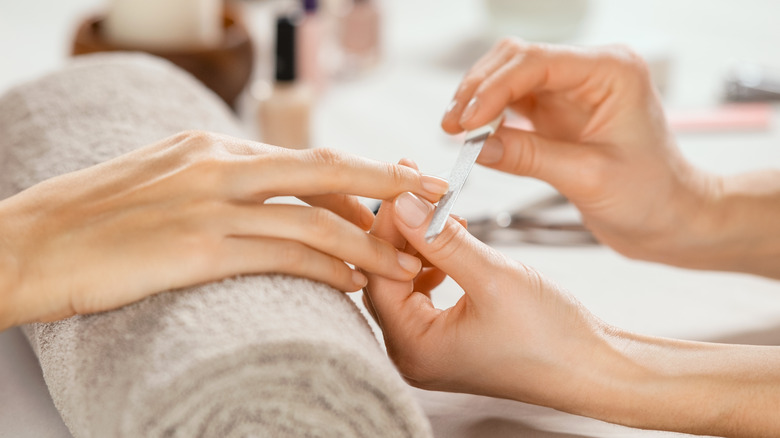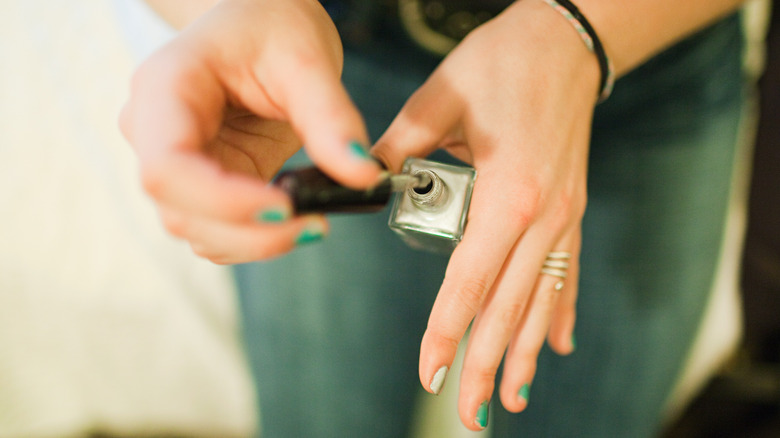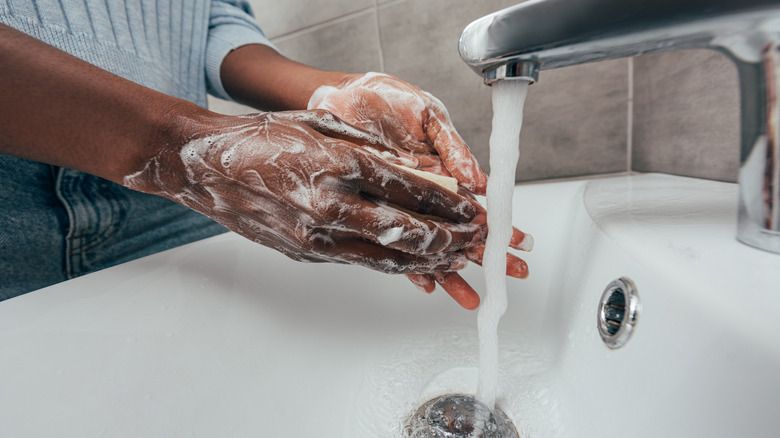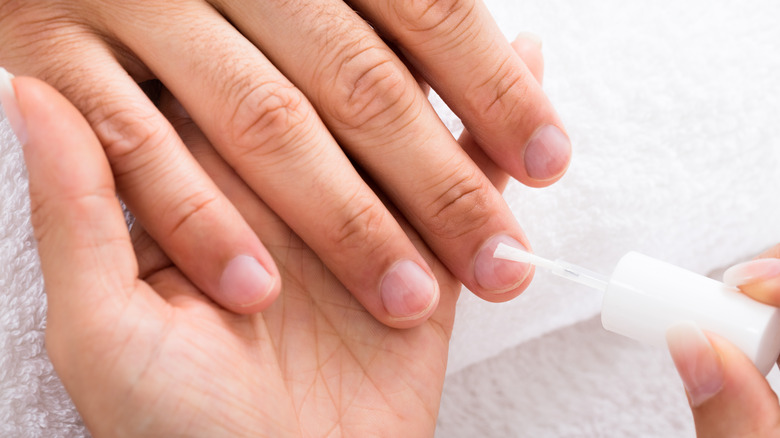What Is Onycholysis? The Fingernail Condition Explained
Whether you're attending a big event or just going out with your friends, sporting luxe nails is a must. However, anyone who has ever tried to maintain a beautiful manicure can tell you that hard work goes into keeping nails looking flawless. In between trims, cuticle moisturizing, and filing, nail maintenance is a never-ending task. Throw nail polish or fake nails into the mix, and you've given yourself even more to juggle.
Even those who prefer to have their nails maintained at a salon know that it takes time (and money) to keep them looking their best — but what happens when the health of your nails begins to deteriorate? Depending on the underlying cause, it might be worth investigating.
Your nails are made up of layers of keratin and grow directly from the base of your cuticles. Healthy nails are usually smooth and have a uniform color; if this isn't the case for you, there could be an actual medical reason for it. Onycholysis, for example, is one fingernail condition that has several different causes. Although anyone can develop onycholysis, you might be increasing your risk, depending on what you use on your nails. Here is what you need to know about the condition.
Common signs of onycholysis
If you've noticed that one of your nails appears to be separating from your skin, you could have a condition known as onycholysis, according to the Cleveland Clinic. In most cases, you won't feel any pain when you have this ailment, but it can be downright unsightly. Depending on the cause of the condition, you could also experience irritation.
Other symptoms that you might have onycholysis include a thick nail bed, an unusual border between the white edge of your nail and its pink area, and general discoloration. Some colors you may see in an affected nail include gray, yellow, green, white, or purple. Dents or pits in your nails are also telltale signs, as well as any crumbling.
It's important to note that in many cases, onycholysis only affects a single nail. The exception to this is when you have an underlying medical condition, such as anemia or hyperthyroidism. Yeast infections can also cause onycholysis if they become severe. In the event that you notice any of these symptoms, it's important to talk to your doctor for an official diagnosis. From here, you can try to identify the cause and decide on a treatment method that works best for you.
Severe and unexpected causes of onycholysis
Some of the causes of onycholysis can be severe, which is why it's imperative to pay attention to the look and feel of your nails to assess their health on an ongoing basis. Even if you haven't had any nail health problems in the past, this doesn't mean that you're immune to them.
In addition to yeast infections, mineral and nutrient deficiencies, and hyperthyroidism, onycholysis can be caused by psoriasis, which only your doctor can diagnose (via Healthline). You could also have a fungal infection that caused the onset of onycholysis, or you may be experiencing a reaction to a new medication. Trauma to the nail is also a common cause of onycholysis — getting a nail caught in a closing door, for example, can result in the condition.
What you might not want to hear, however, is that certain nail cosmetics can result in the development of onycholysis. If you're allergic to artificial nail tips or a certain chemical in nail polish, for instance, you may experience this condition. Needless to say, this can put a damper on your ongoing goal to flaunt flawless nails, especially if you're a regular at the salon.
Can you cover up nails affected by onycholysis?
In the event that you notice symptoms of onycholysis, the most important thing to do is to contact your doctor. However, we've all been in a pinch before — if you have an important upcoming engagement and one of your nails looks unsightly, you may feel inclined to paint over it or visit the salon until you can seek treatment. That being said, most technicians know our nails are key indicators of our health, and they may suggest you visit your doctor rather than receive a rushed manicure. If the technician does agree to proceed with a manicure or pedicure, they might do what they can to prevent the onycholysis symptoms from worsening. This includes keeping your nail bed dry and shortening any artificial length you've added to the nail (rather than removing it) to prevent further damage, according to NAILS Magazine.
Once you see your doctor and identify the cause of onycholysis, you can begin to receive treatment. If the condition is the result of an injury, you might not require extensive treatment, as the nail will heal itself over time. However, you may require medication if the cause is a fungal infection, for example (via Medical News Today). During the healing process, you will likely need to avoid nail cosmetics as you keep the affected area as clean as possible.
Onycholysis as a result of outlying factors
If you've always thought you meticulously cared for your nails, you may be surprised in the event that you're diagnosed with onycholysis. However, some people are more prone to developing the condition than others. For instance, those who are on an antibiotic known as doxycycline — commonly used to treat conditions like acne — can develop photo-onycholysis in their nails after ultraviolet light exposure, according to NAILS Magazine. Chemotherapy medications have also been known to increase the risk of nail bed injuries.
Sometimes, lifestyle factors can play a role in onycholysis as well. For example, frequent hand-washing can raise the chances of developing a yeast infection, resulting in nail separation. Athletes are also more prone to onycholysis if their toenails come into constant contact with the tips of their shoes.
Unfortunately, the detached portion of your nail cannot be reattached through any type of treatment — you'll most likely need to remove this part of your nail when possible or wait for it to grow out so you can trim it off (via the Cleveland Clinic). Proper medical treatment can help new growth stay attached to your nail bed, eliminating the condition. However, it can take months for the affected nail to fully recover.
How to prevent onycholysis in the future
Once you've had to recover from onycholysis, you might never want to deal with that type of situation again. Although injuries can't be prevented altogether, there are a few ways you can reduce the risk of developing this unsightly nail condition.
If your daily life requires you to wash your hands frequently, wear gloves to protect your nails and cuticles. When onycholysis forms as a result of a vitamin deficiency or medical condition, such as psoriasis, you'll need to talk to your doctor about how to maintain your nail health, per Medical News Today. They can provide insight into how to manage the side effects of your specific illness, such as the potential for your nails to lift from your nail beds. If your issue can be linked back to nutrient deficiencies, your doctor can also help you safely make dietary changes.
Once you begin caring for your nails after your onycholysis diagnosis, be sure to keep them short in length. Avoid filing them, if possible, to prevent adding any pressure to the nail during the healing process. It also isn't necessary to clean under the affected nails while they're recovering. Similarly, don't cover up the nails with wound dressing, such as bandages, as it can encourage bacterial growth.
Warning signs to look out for in your nails
Onycholysis is one example of a nail condition that can develop as a result of a different underlying illness. As it turns out, there are many warning signs that our nails can give us to signify that it's time to seek medical advice.
Discoloration is one of the most common symptoms of an underlying condition, according to the Mayo Clinic. If you notice a sudden change in the color of an entire nail or even just a discolored streak, bring it up to your doctor. Changes in the shape of your nails can be indicative of a health condition as well. While onycholysis might result in your nail lifting from its nail bed, don't ignore thinning or thickening of your nails — these may also be symptoms of a different ailment.
Finally, do your best to pay attention to the growth of your nails. If you aren't noticing any growth over time, contact a medical professional. They can help you pinpoint the cause and present potential treatment options.






